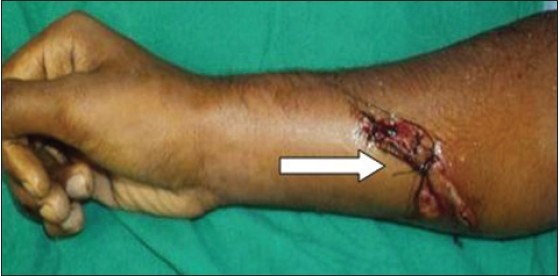Abstract
Superficial ulnar artery is an uncommon variation in which the ulnar artery is having its course superficial to the flexors of the forearm and may arise directly from axillary or brachial arteries. The proper understanding and knowledge of variation of arterial systems is helpful for judicious planning of various reconstructive procedures in oncological, orthopaedic and reconstructive surgeries. We present a case of variant course of ulnar artery which was noted during exploration of a right distal forearm wound. We suggest few clinical recommendations to avoid iatrogenic complications due to variation in arterial system.
Keywords: Forearm wound, iatrogenic complication, superficial ulnar artery, ulnar artery, ulnar nerve
INTRODUCTION
Variation in arterial system in extremities is a challenging clinical question in vascular and reconstructive surgeries and radiographic evaluation of angiographic studies. Superficial ulnar artery is an uncommon variation in which the ulnar artery is having its course superficial to the flexors of the forearm and may arise directly from axillary or brachial arteries. We present a case of variant origin and course of ulnar artery which was noted during exploration of a right distal forearm wound for radial artery, median nerve and flexor tendon injuries.
CASE REPORT
A 22-year-old male had sustained glass cut injury to his right forearm and presented with an actively bleeding wound with tag suturing performed at another centre and referred to our centre [Figure 1]. On examination, there was pulsatile bleeding from the wound with diminished radial artery pulsations compared to the normal side. In addition, he had painful restriction of the movements of the wrist and digital joints with decreased sensation of the palm. On exploration, the radial artery and the median nerve were partially injured and there was total division of the palmaris longus, flexor carpi radialis and superficial flexors of the ring and middle fingers. A large but intact superficial artery was found on the ulnar side of the wound and this side was explored to rule out ulnar neurovascular injury. The ulnar nerve was intact and was in its normal course but without the accompanying ulnar artery [Figures 2 and 3] and therefore it was concluded that the artery was a superficial anatomical variation of the ulnar artery. An intraoperative ultrasound doppler revealed the normal course of brachial artery in the arm and dividing into ulnar and radial artery with the ulnar artery taking a superficial course from the proximal forearm. The ultrasound doppler study and clinical absence of ulnar artery in its normal course with ulnar nerve confirmed the diagnosis of superficial ulnar artery.
Figure 1.

Preoperative clinical picture showing sutured forearm wound [white arrow]
Figure 2.

The radial artery [black arrow] is seen with partial injury and superficial ulnar artery is seen [white arrow]
Figure 3.

The ulnar nerve [white arrow] is shown in its normal location and the ulnar artery was absent in its anatomical location and superficial ulnar artery is seen [black arrow]
DISSCUSION
Superficial ulnar artery incidence is 0.7-9.3% and has unilateral preponderance.1 This arterial variation is associated with other anatomical variations such as absent palmaris longus2 and abnormal superficial palmar arch. The superficial ulnar artey usually arises in arm or axilla and has a superficial course in the forearm.3,4 Intra operative ultrasound doppler and preoperative and postoperative angiogram is helpful for tracing the course of the superficial ulnar artery.
The clinical significance of course of superficial ulnar artery makes it susceptible for cut injuries in arm, forearm leading to severe bleeding.5 Also superficial ulnar artery can be mistaken as vein and intravenous medications can be administered in it.6
The superficial ulnar artery variation is important during forearm flaps surgeries and radial artery thrombosis with forearm injuries. The proper understanding and knowledge of variation of arterial systems is helpful for judicious planning of various reconstructive procedures in oncological, orthopaedic and reconstructive surgeries.
Clinical Recommendations
Use of intraoperative Doppler ultrasound an important surgical aid for reconstructive and orthopaedic surgeons
To trace arterial vessels at normal anatomical location with help of neurovascular structures
Preoperative angiogram in flap surgery may help to trace the course of variant artery and its site of origin
Proper surgical dissection and anticipation of various variant arterial systems in limb surgeries.
It is important to recognize this condition as inadvertent injections or injury during a surgical procedure may cause distal limb ischaemia.
Footnotes
Source of Support: Nil
Conflict of Interest: None declared.
REFERENCES
- 1.Rodriguez-Niedenfuhr M, Vazquez T, Parkin IG, Sanudo JR. Arterial patterns of the human upper limb: Update of anatomical variations and embryological development. Eur J Anat. 2003;7:21–8. [Google Scholar]
- 2.Yadav PS, Ahmad QG, Shankhdhar VK, Nambi GI. Absence of Palmaris longus is a warning sign for avoiding the superficial ulnar artery trap. Indian J Plast Surg. 2013;46:149–50. doi: 10.4103/0970-0358.113738. [DOI] [PMC free article] [PubMed] [Google Scholar]
- 3.Fadel RA, Amonoo-Kuofi HS. The superficial ulnar artery: Development and surgical significance. Clin Anat. 1996;9:128–32. doi: 10.1002/(SICI)1098-2353(1996)9:2<128::AID-CA5>3.0.CO;2-D. [DOI] [PubMed] [Google Scholar]
- 4.Panagouli E, Tsaraklis A, Gazouli I, Anagnostopoulou S, Venieratos D. A rare variation of the axillary artery combined contralaterally with an unusual high origin of a superficial ulnar artery: Description, review of the literature and embryological analysis. Ital J Anat Embryol. 2009;114:145–56. [PubMed] [Google Scholar]
- 5.Senanayake KJ, Salgado S, Rathnayake MJ, Fernando R, Somarathne K. A rare variant of the superficial ulnar artery, and its clinical implications: A case report. J Med Case Rep. 2007;1:128. doi: 10.1186/1752-1947-1-128. [DOI] [PMC free article] [PubMed] [Google Scholar]
- 6.Chin KJ, Singh K. The superficial ulnar artery - a potential hazard in patients with difficult venous access. Br J Anaesth. 2005;94:692–3. doi: 10.1093/bja/aei548. [DOI] [PubMed] [Google Scholar]


